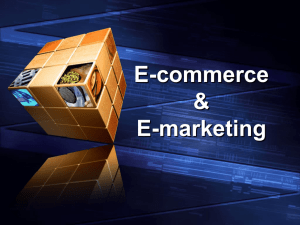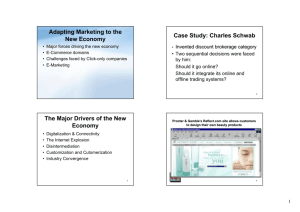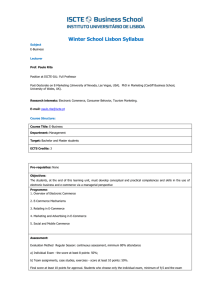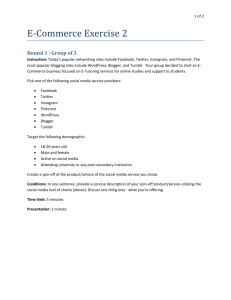- Webnode
advertisement
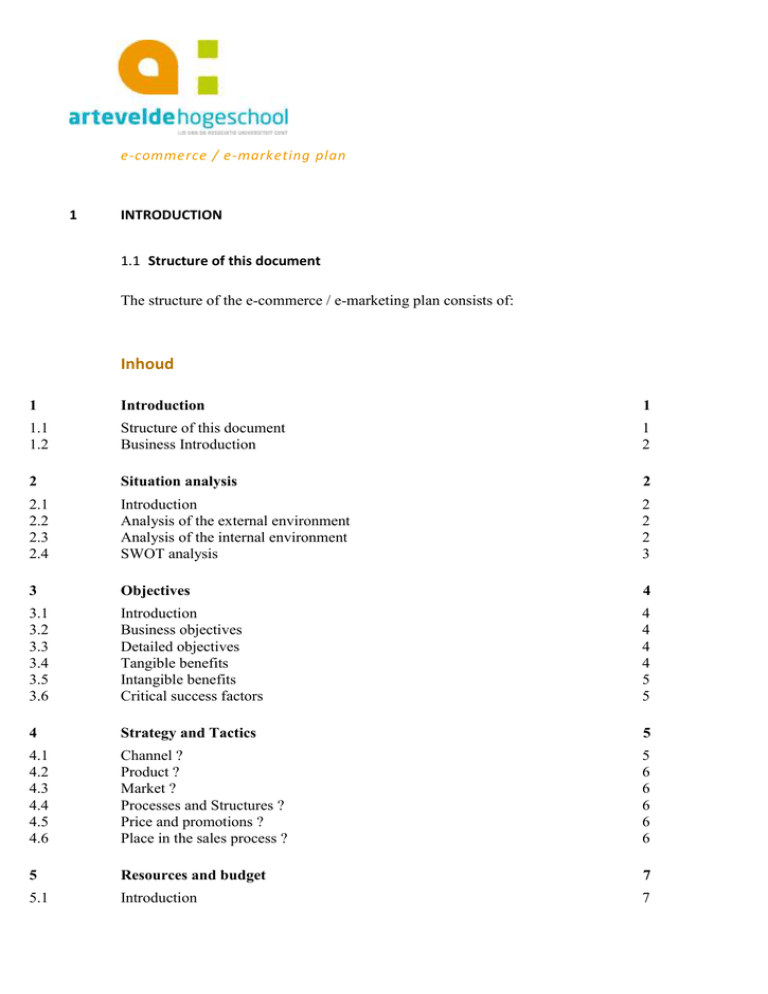
e-commerce / e-marketing plan 1 INTRODUCTION 1.1 Structure of this document The structure of the e-commerce / e-marketing plan consists of: Inhoud 1 Introduction 1 1.1 1.2 Structure of this document Business Introduction 1 2 2 Situation analysis 2 2.1 2.2 2.3 2.4 Introduction Analysis of the external environment Analysis of the internal environment SWOT analysis 2 2 2 3 3 Objectives 4 3.1 3.2 3.3 3.4 3.5 3.6 Introduction Business objectives Detailed objectives Tangible benefits Intangible benefits Critical success factors 4 4 4 4 5 5 4 Strategy and Tactics 5 4.1 4.2 4.3 4.4 4.5 4.6 Channel ? Product ? Market ? Processes and Structures ? Price and promotions ? Place in the sales process ? 5 6 6 6 6 6 5 Resources and budget 7 5.1 Introduction 7 5.2 5.3 5.4 5.5 5.6 5.7 5.8 Project timeline assumption Tasks & Resources Headcount evolution to run our project Non-labor costs Total budget Month over month budget requirements Conclusion 7 7 8 9 9 9 10 6 Measurement & Control 11 6.1 6.2 6.3 6.3.1 6.3.2 Introduction Defining KPi’s & Segments Define your analytics goals Identify conversions Define the goals matching those conversions. 11 11 14 14 15 Italic text in this document is comment – is to be removed from the final e-commerce plan 1.2 Business Introduction Introduce in a couple of lines the business this e-commerce / e-marketing plan will address. 2 SITUATION ANALYSIS 2.1 Introduction This chapter will provide an analysis of the 1. Analysis of the external environment 2. Analysis of the internal environment 3. SWOT analysis 2.2 Analysis of the external environment Place here a pointer to the analysis of the external environment, already covered by the competitor analysis (modules 28-30). This should normally match what is required under this paragraph. 2.3 Analysis of the internal environment This is often called describing the “As-Is” situation. You should do an audit in the company to understand those topics which are relevant for our future e-business solution. Typical domains you should investigate and document your findings are: 2 / 15 Arteveldehogeschool Error! Reference source not found. Error! Reference source not found. Current marketing approach Investigate/list how marketing is done today Current Internet presence What is your current internet presence (e.g. website, internet marketing, social media,…) Example: We have a static website with downloadable excel document with current standard product and pricelist. There is a business Facebook page, but we use it only occasionally e.g. after an event to post some photo material Current resources and skills How about the skills and the availability of resources in your company. Document your current resources and their skills. While doing so, mark people in your organization who will be able to take up specific roles related to maintaining the ecommerce solution (for example ICT activities, graphical design, text writing, product catalogue maintenance, order processing,…) You need also to check who is involved in customer orders intake, handling and delivery in the as-is situation. Document where they are located (you will need staff to pick and dispatch orders coming from the e-business platform. Example: We don’t have an ICT professional in our company. We have one person available 20% of her time for communication management and 10% of the time available to maintain the products and descriptions in the ERP system. (Interpretation: this person might be suited for website content management and catalog management of the webshop) Processes and infrastructure for delivery Which processes and infrastructure to deliver products to customers are present (or lacking) Example: We have 3 brick shops, no dedicated warehouse. In case a brick shop is out of stock, we might fetch the product a customer is requesting from another shop. We rarely ship parcels, customers simply come to our shop. ICT landscape What is the ICT landscape you are currently using ? Think of domains such as systems for order intake, billing, production, logistics, inventory, customer relationship ? Example: We have a Microsoft dynamics CRM and a Microsoft Navision ERP system. For bookkeeping Cubic Pro is used. 2.4 SWOT analysis The SWOT analysis you have already studied in modules 26-27 and you prepared it for your business case in module 31. So refer to that and you are done 3 / 15 Arteveldehogeschool Error! Reference source not found. Error! Reference source not found. 3 OBJECTIVES 3.1 Introduction This chapter explains what we want to achieve by bringing the e-commerce and e-marketing solution in place. We will cover Business objectives Detailed objectives We will also have a look into the critical success factors to achieve this. 3.2 Business objectives Our mission statement: Write a “mission statement” about the objectives you want to reach using e-marketing and e-business for your company. Example ebay: "Ebay's mission is to provide a global trading platform where practically anyone can trade practically anything." 3.3 Detailed objectives This paragraph lists the detailed objectives of the e-marketing and e-business solution. This is done by identifying the benefits we want to achieve, both: Tangible benefits Intangible benefits Benefits are looked into both from a customer and provider view. 3.4 Tangible benefits A tangible benefit is a real benefit which should be straight forward to confirm. (For example it is easy to measure and associate with your webshop) We identified: 1. Examples: 4 / 15 Arteveldehogeschool Error! Reference source not found. Error! Reference source not found. Increase sales by adding an online channel which will address a geographically more spread customer base then what we can cover through our brick shops. Reduce the cost of a remote order by having a shorter processing time (labour cost) compared to the processing time we measure for orders coming in by phone or mail. 3.5 Intangible benefits An intangible benefit is an indirect benefit which can't be felt or touched. Their result is harder to measure or verify We identified: 1. Examples: The conservative shop image we have might improve by adding an online offering Improve customer satisfaction for our brick customers by adding an e-business support solution for warranty claims. 3.6 Critical success factors Critical success factors must be fulfilled in order to achieve the above objectives. We identified following critical success factors: 1. If you are aware of key elements which could cause that these objectives are not achieved, you should mention them. This paragraph should have management attention to make sure one tries to fulfill those critical success factors Example: 4 End users must be made available and pulled from their normal demanding work activities to provide input to the design team STRATEGY AND TACTICS An overview of the strategy and tactics that will be applied to the e-commerce / e-marketing solution: 4.1 Channel ? 5 / 15 What is your new channel mix ? Only webshop, mix of online and bricks ? Main focus remaining on bricks ? Arteveldehogeschool Error! Reference source not found. Error! Reference source not found. 4.2 Product ? Are you offering the same products as “brick” based ? Or can you offer new formats (e.g. digital media download). 4.3 Market ? What is your strategy regarding your target markets ? Will the online platform address new or other markets then your brick offering ? (e.g.: other geography, lower specification products for a price conscious young public,…) 4.4 Processes and Structures ? What is the new company organization, structure, processes, way of working you want to introduce. 4.5 Price and promotions ? Is your price the same on the webshop as in the brick shops ? Webshop somewhat cheaper standard price ? Lower spec. cheaper products on webshop ? New price methods available such as auction ? Example: many businesses have on e-bay a business webshop using the auction principle besides their brick offering with classic pricing. 4.6 Place in the sales process ? Are you the seller, the buyer, the market place Example: www.ebay.com is an intermediary offering the marketplace (and gaining money mainly on the transactions). www.2dehands.be is an intermediary offering the marketplace and gaining money mainly from advertising (banners, but also the ranking of your product on offer) 6 / 15 Arteveldehogeschool Error! Reference source not found. Error! Reference source not found. 5 RESOURCES AND BUDGET 5.1 Introduction Introducing and running the e-business solution will cause costs and a workload on our organization. This chapter provides an estimation of those costs and workload. Please refer to excel file “e-commerce budget template.xlsx” for more detail on those calculations 5.2 Project timeline assumption We assumed that the project will have an analysis, design & implementation phase and an ongoing operations phase. During the ongoing operations phase the e-commerce solution is used in production. Following timeline was assumed: Services Analysis, Design & Implementation Ongoing Operations Start Date Duration End Date 9/12/2012 60 7/02/2013 8/02/2013 1086 30/01/2016 (Cut and paste your timeline from tab “cover” in “e-commerce budget template.xlsx”) 5.3 Tasks & Resources Below table provides an overview of the main tasks, the resources who will handle those, and the effort to be spend over time for those activities. (Cut and paste your tasklist from tab “hc_walk” in “e-commerce budget template.xlsx”) 7 / 15 Arteveldehogeschool Error! Reference source not found. Error! Reference source not found. 5.4 Headcount evolution to run our project The headcount evolution required for our project then looks as: (Cut and paste this graph from tab “hc_walk” in “e-commerce budget template.xlsx”) 8 / 15 Arteveldehogeschool Error! Reference source not found. Error! Reference source not found. 5.5 Non-labor costs Besides the resources required for our e-commerce project, we do have a number of fixed and variable costs. Those are: (Cut and paste this table from tab “hc_walk” in “e-commerce budget template.xlsx”) 5.6 Total budget Based upon above estimations and assumptions, we believe this project will required following running budget: (Cut and paste this table from tab “hc_walk” in “e-commerce budget template.xlsx”) 5.7 Month over month budget requirements 9 / 15 Arteveldehogeschool Error! Reference source not found. Error! Reference source not found. (Cut and paste this graph from tab “hc_walk” in “e-commerce budget template.xlsx”) 5.8 Conclusion The conclusion recapitulates the main attention points (e.g. resource peak, required budget) and also refer to bringing this cost in relation to the expected sales increase you hope to achieve. You could further refine this by working with an accountant in order to calculate break-even, projected profit and loss, gross margin, etc… 10 / 15 Arteveldehogeschool Error! Reference source not found. Error! Reference source not found. 6 MEASUREMENT & CONTROL 6.1 Introduction This chapter discusses how we will verify that we achieve what was planned. This is done by detailing our plan for measuring and the metrics that will be used to validate an objective is achieved. We will focus on digital analytics. We will look from 2 angles to this: Business result There is a business result – Verification our webshop is contributing to the profitability of the company Marketing result There is a marketing effect. Even if your webshop is loss making, it can still be very useful for customer satisfaction, customer loyalty, cross channel sales, your reputation… To prepare for this activity, make sure you have attended the google analytics academy introduction course: https://analyticsacademy.withgoogle.com/course. You need to watch modules 2 till 4 in order to be able to comlete this part of the e-commerce plan. 6.2 Defining KPi’s & Segments (Have a look at https://analyticsacademy.withgoogle.com/course unit 2.4, creating a measurement plan, as preparation for this activity) Let’s define meaningful KPI’s and Segments, starting from the business objectives and tactics identified earlier on in this plan. (Take in account that you can have both business result focuses and marketing result focused ones. For each business objective/Tactic bundle you have, define the KPI and the Segment you will be using. Your KPI will in most cases be different for different objective/tactic bundles. Your Segments might be the same or different for different Objective/Tactics bundles. What are the key performance indicators you want to have (the number you will look at day to day to see how your business is performing) to measure the success of your strategy ?) Business objective 1: Tactics KPI’s (e.g. : "Sell products") Tactic 1 Tactic 2 (e.g. : “Sell Online”) (e.g.: "Drive visitors to brick shop") ... 1 (e.g. : Revenue €) (e.g.: #find store events) 2 (e.g.: Avg. Order value €) (e.g.: #coupons printed) 3 4 Segments 1 e.g. Marketing Channel: Search + Facebook (explain) 2 3 4 12 / 15 Arteveldehogeschool Error! Reference source not found. Error! Reference source not found. Tactic 3 Business objective 2: Tactics KPI’s (e.g. : "Sell products") Tactic 1 Business objective 3: Tactics Segments 13 / 15 Arteveldehogeschool Tactic 3 Tactic 2 Tactic 3 1 2 3 4 1 2 3 4 Segments KPI’s Tactic 2 (e.g. : "Sell products") Tactic 1 1 2 3 4 1 2 3 4 Error! Reference source not found. Error! Reference source not found. 6.3 Defining the analytics goals (Have a look at https://analyticsacademy.withgoogle.com/course unit 4.4, setting up goals and ecommerce, as preparation for this activity) 6.3.1 Identifying conversions Let’s identify the interesting micro and macro conversions. We organise them in logical conversion sets, where micro conversions lead eventually to the macro conversion of that set. This is documented in below table. (Give your conversion set a name. List under “Conversion Description” the micro and macro conversions. Maintain a chronological order if there is one. You should only have one macro conversion as last step. An example:) Conversion set 1: Conversion set 2 14 / 15 (e.g.: Buying a product) Conv. Type Conversion Description Goal Name (e.g.: Micro) (e.g.: Reading product specs) (e.g.: Micro) (e.g.: Watch product video) (e.g.: Micro) (e.g.: Place product in basket) (e.g.: Macro) (e.g.: Buy) (e.g.: Visit brick shop) Conv. Type Conversion Description Goal Name (e.g.: Micro) (e.g.: print voucher) (e.g.: (e.g.: present voucher in brick Macro) shop when buying) Arteveldehogeschool Error! Reference source not found. Error! Reference source not found. IsKPI Goal type Goal rule IsKPI Goal type Goal rule Y 6.3.2 Defining the goals matching those conversions. (Your goal name will often match the conversion description, don’t worry about that. Some of the goals match an KPI. If that is the case, mark it with a “Y”. That will often be the one matching a macro conversion. Goals come in 4 types: Destination (e.g. thanks.html), Duration (ex: 5 minutes or more). Pages/Screen visit (eg. 3 pages). Event (eg. Played video). Document this type in the Goal Type column (only using one of those 4 values) The column Goal Rule describes the boundary and test you want de set up. Below you find an example: ) Conversion set 1: (e.g.: Buying a product) Conv. Type Conversion Description Goal Name (e.g. Stay long enough) (e.g.: Watch product video) IsKPI Goal type N (e.g. Duration) Goal rule (e.g; >= 5 minutes on site) N (e.g.: Browse products) (e.g.: Buying) N Y (e.g. played a video) (e.g.: >= 5 pages looked at) (e.g.: thanks.html) (e.g.: Event) (e.g.: Pages/Screens per visit) (e.g.: Destination) Now it’s your turn: identify your conversions, and the matching goals, and document them in above template structures. Have as many tables as you have conversion sets. Once done, this can be given to the analytics team for implementation. 15 / 15 Arteveldehogeschool Error! Reference source not found. Error! Reference source not found.


